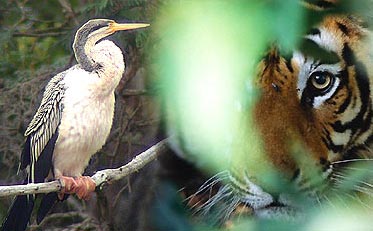 |
 |
 |
||
|
||||
Bird Conservation
Religious Attitudes and Traditional Protection
The enlightened and benevolent attitudes towards wildlife of Hinduism and Buddhism have undoubtedly helped to conserve the rich natural heritage of the Indian subcontinent that still remains today.
India has a tradition of protection of all forms of animals dating from as early as 3000 years ago, when the Rig Veda mentioned the animals' right to live. Several communities, such as the Buddhists and the Jains, protect living creatures in daily life. Sacred groves, village tanks and temples where the hunting and killing of all forms of life are prohibited can be found throughout India.
Current Threats
Birds in the region are currently confronted with many threats, the most important of which are habitat loss and deterioration. Root causes of loss of and damage to habitats are complex, interlinked and often controversial. Overpopulation is often blamed for the region's environmental ills; India is predicted to take over from China as the world's most populous nation by the year 2020. Other factors are, however, important: poverty, inequitable land distribution, insecurity of tenure, lack of political will, weak government, national debt (which encourages countries to overexploit their natural resources for export), damaging international policies, high demand from overseas for resources, and misguided national policies.
Threats to Forests
Both the extent and the quality of forest resources are declining throughout much of the region. In 1997, the government estimated India's forest cover to be over 19% of the country's area, but only 11.2% of forest is dense (Forest Survey of India 1997). Only 15% of Nepal carried dense forest by 1988. Bangladesh's productive forest cover was only 6-7% in the 1990s and much of what remains is heavily degraded (Collins et al. 1991; Rahman 1995). Natural forest cover in Sri Lanka had dwindled to 18.9% in 1983 (Collins et al. 1991) and according to the United Nations Food and Agricultural Organization, only 2.8% of Pakistan's land is under forest. Bhutan, however, still retains much of its forest relatively intact, with 43% of its land area under high-density forest in 1991; the country possesses some of the best forest habitats left in the Himalayas.
The major threats to natural forest are overexploitation for fuelwood, timber and fodder, overgrazing which prevents forest regeneration, and the conversion of forest to other land uses: agriculture, notably shifting cultivation, tree plantations, urban land, and reservoirs through dam construction. The decline in Nepal's forest cover has been attributed partly to the breakdown of traditional management.
Threats to Wetlands
Wetland destruction and degradation in the region are reducing the diversity of wetlands and the population numbers of many bird species. Major threats include overexploitation of wetland resources, as local demands often exceed wetlands' ability to regenerate. Increasing hydroelectric developments are altering the characteristics and dynamics of entire river ecosystems in the region. Drainage and siltation of wetlands and intensive prawn cultivation are other major threats. Many wetlands are becoming polluted by sewage, industrial effluents and agricultural fertilisers and pesticides, although these impacts have not been quantified on a national basis.
Deforestation has resulted in habitat loss for some waterbirds. Swamp forest, which was once extensively distributed in Bangladesh, is now on the verge of disappearing. Mangrove areas, too, have also been severely damaged in many parts of India and completely wiped out in some areas.
While many of the region's natural wetlands have disappeared, new wetlands have been created. These include lakes and marshes upstream of dams and barrages on some rivers, certain of which now provide excellent habitat for waterbirds. Other wetlands have developed as a result of faulty drainage systems and overspill from irrigation canals. Rice production has also created large areas of seasonally useful habitat for some waterbirds in parts of the region, although in Bangladesh natural wetlands are being reclaimed for production of rice.
Threats to Grasslands
Grassland has been greatly reduced, fragmented and degraded by large-scale expansion of agriculture, conversion to other kinds of land use, drainage, and overgrazing. Apart from grasslands located within protected areas, practically every grass-growing tract in the region is grazed by domestic livestock. Encroachment by graziers is also increasing in protected areas. Large increases in livestock have led to widespread overgrazing, and this problem has been exacerbated as more and more grazing lands have been converted to other land uses.
Threats to Desert
The spread of irrigation has significantly reduced the habitat of desert birds. Between 1950 and 1990, the area under irrigation increased by 70% in Pakistan and by as much as 118%
in India.
Threats to Agricultural Habitats
Agricultural practices have become significantly intensified in recent years in most of the region, leading to increased production. Pesticide use has also increased, including use of the organochlorines DDT and aldrin, both of which have been proved to be particularly poisonous to birds. Pesticides build up in food chains, particularly affecting species at the apex, notably birds of prey. Pesticides leached from agricultural land contaminate rivers and streams and build up in aquatic food chains, thereby affecting fish and fish-eating birds. In Europe, such factors have been shown to cause widespread declines of numerous bird species, many of which were previously common, including birds of prey, shrikes and finches (Tucker and Heath 1994). Could the same be happening in the Indian subcontinent? This seems likely, although there is little direct evidence so far.
Other Threats
Hunting is a major threat to some species in Pakistan (notably cranes and bustards) and in Bangladesh (particularly migratory waterfowl and waders). Local fishermen collect eggs of seabirds wherever they nest colonially in Pakistan and the Maldives. Persecution is so great in the Maldives that it seems doubtful whether many young of any seabird species now survive (Ash and Shafeeg 1995). Similar predation is also reported on Black-bellied Tern Sterna acuticauda, River Tern S. aurantia and Small Pratincole Glareola lactea along rivers in Pakistan and may well account for the relative decline in these species (Roberts 1991). In parts of India and Nepal, hunting is on the increase as traditional values wane and is significant for several species, notably threatened bustards and some pheasants.
Until very recently there was a large domestic and international bird trade in India, but since 1991 all bird trade has been banned. Recent undercover operations have, however, revealed that thousands of birds are still regularly caught and traded, both within India and for export, although in much-reduced numbers compared with those previously traded. Caged birds are popular in Pakistan. In recent years, in the Maldives, a very large trade seems to have developed in the marketing of wild birds as pets (Ash and Shafeeg 1995).
Introduced species of fauna and flora are a common threat to native birds (and other wildlife) on a worldwide scale. In the subcontinent, for example, large areas of natural habitat have been colonised by exotic plant species, such as the water hyacinth Eichhornia, which covers the surface of fresh waters, thus changing the habitat for many waterbirds.
Consequences
Losses and deterioration of habitats and other threats have resulted in widespread declines in bird populations, but we can only speculate on the changes that are occurring for most species. Apart from the annual waterfowl counts organised by Wetlands International and the International Waterfowl and Wetlands Research Bureau, and some studies on rare species, there is a lack of baseline data for monitoring most birds, especially common and widespread species.
In 1994, BirdLife International published a world list of 1111 bird species (11 % of the world's avifauna) threatened with extinction, including 78 species which regularly occur in the Indian subcontinent (Collar et al. 1994). A book currently in preparation, Threatened Birds of Asia, will describe all Asian species at risk of extinction, highlighting the threats they face and the conservation measures proposed to save them; data are being compiled by national co-ordinators in each country.
Conservation Measures
Traditional protection, religious beliefs, legal measures and the efforts of conservation organisations have all helped to counter, albeit only partially, the threats confronting birds in the subcontinent. Without them, the region's extinct and threatened bird species would be much greater in number.
In addition to the impact of religious beliefs and traditional protection, legal conservation measures are in force in all countries in the subcontinent. The Convention on Biological Diversity has been ratified by all countries in the region. This commits member countries to conserve the variety of animals and plants within their jurisdiction and to aim to ensure that the use of biological resources is sustainable. All the subcontinent countries with major wetlands have ratified the Convention on Wetlands of International Importance, the Ramsar Convention. This requires the protection of wetlands of international importance, the promotion of wetlands and the fostering of their wise use.
There is widespread protected-area coverage. The recently revised protected-areas system n Bhutan is especially impressive, covering 22% of the country and representing all of its major ecosystems. Large proportions of Nepal (10.6%) and Sri Lanka (12.1 %) are also covered by protected areas. Protected-area coverage is 4% in India, 4.7% in Pakistan and 0.8% in Bangladesh.
Local, national and international non-governmental organisations have made a major impact on bird conservation. The main national and international organisations and their activities are listed below.
NATIONAL ORGANISATIONS
INDIA
Bombay Natural History Society (BNHS), Hornbill House, Dr Salim Ali Chowk, Shaheed Bhagat Singh Road, Bombay 400 023.
Publ ications: Journal of the Bombay Natural History Society; Hornbill magazine (quarterly).
Salim Ali Centre for Ornithology and Natural History (SACON), Kalampalayam, Coimbatore, Tamil Nadu 641 010. Publication: SACON newsletter.Wildlife Institute of India (WII), Post Bag No. 18, Chandrabani, Dehradun 248 001.
Bird Conservation Nepal (BCN), Post Box 1246S, Kathmandu.
Publication: Danphe newsletter (quarterly).
SRI LANKA
Ceylon Bird Club, Ceylon Bird Club, 39 Chatham Street, Colombo 1.
Publication: Ceylon Bird Notes (monthly).
Field Ornithology Group of Sri Lanka (FOGSL), Department of Zoology, University of Colombo, Colombo 03. Publication: Malkoha (quarterly).
BHUTAN
Royal Society for the Protection of Nature (RSPN), PO Box No. 325, Thimphu.
Publications: Thrung Thrung newsletter (half-yearly); Rangzhin magazine (quarterly).
PAKISTAN
Ornithological Society of Pakistan (OSP), Near Chowk Fara, Block 'D', PO Box 73, Dera Ghazi Khan 32200. Publication: Pakistan Journal of Ornithology.
BANGLADESH
Nature Conservation Movement (NACON), Anisuzzaman Khan (Executive Director), 125-127 (2nd floor) Nohammadia Super Market, Sobhanbag, Dhaka 1207.
Wildlife Society of Bangladesh, Department of Zoology, University of Dhaka, Dhaka.
Centre for Advanced Research in Natural Resources and Management (CARINAM), R. M. A. Rashid (President), 70 Kakrail, Dhaka 1000.
INTERNATIONAL ORGANISATIONS
BirdLife International, Wellbrook Court, Girton Road, Cambridge CB3 ONA, UK.
Publication: World Birdwatch magazine (quarterly).
Wetlands International - Asia Pacific, Institute of Advanced Studies, University of Malaya, Lembah Pantai, 50603 Kuala Lumpur, Malaysia. Publication: Asian Wetland News.
World Pheasant Association South Asia (WPA-SARO), do WWF India, 172-B Lodi Estate, New Delhi 110023, India. Publication: WPA India News.
World Wide Fund for Nature (WWF)
WWF India, 172-B Lodi Estate, New Delhi 110023.
WWF Pakistan, UPO Box 1439, University of Peshawar, Peshawar, N.W.F.P.
WWF Nepal, PO Box 7660, Lal Durbar, Kathmandu.WWF Bhutan, PO Box 210, Thimphu.
Oriental Bird Club (OBC), The Lodge, Sandy, Bedfordshire SG19 2DL, UK.
Publications: OBC Bulletin (half-yearly); Forktai/ journal (annual).
Religious Attitudes and Traditional Protection
The enlightened and benevolent attitudes towards wildlife of Hinduism and Buddhism have undoubtedly helped to conserve the rich natural heritage of the Indian subcontinent that still remains today.
India has a tradition of protection of all forms of animals dating from as early as 3000 years ago, when the Rig Veda mentioned the animals' right to live. Several communities, such as the Buddhists and the Jains, protect living creatures in daily life. Sacred groves, village tanks and temples where the hunting and killing of all forms of life are prohibited can be found throughout India.
Current Threats
Birds in the region are currently confronted with many threats, the most important of which are habitat loss and deterioration. Root causes of loss of and damage to habitats are complex, interlinked and often controversial. Overpopulation is often blamed for the region's environmental ills; India is predicted to take over from China as the world's most populous nation by the year 2020. Other factors are, however, important: poverty, inequitable land distribution, insecurity of tenure, lack of political will, weak government, national debt (which encourages countries to overexploit their natural resources for export), damaging international policies, high demand from overseas for resources, and misguided national policies.
Threats to Forests
Both the extent and the quality of forest resources are declining throughout much of the region. In 1997, the government estimated India's forest cover to be over 19% of the country's area, but only 11.2% of forest is dense (Forest Survey of India 1997). Only 15% of Nepal carried dense forest by 1988. Bangladesh's productive forest cover was only 6-7% in the 1990s and much of what remains is heavily degraded (Collins et al. 1991; Rahman 1995). Natural forest cover in Sri Lanka had dwindled to 18.9% in 1983 (Collins et al. 1991) and according to the United Nations Food and Agricultural Organization, only 2.8% of Pakistan's land is under forest. Bhutan, however, still retains much of its forest relatively intact, with 43% of its land area under high-density forest in 1991; the country possesses some of the best forest habitats left in the Himalayas.
The major threats to natural forest are overexploitation for fuelwood, timber and fodder, overgrazing which prevents forest regeneration, and the conversion of forest to other land uses: agriculture, notably shifting cultivation, tree plantations, urban land, and reservoirs through dam construction. The decline in Nepal's forest cover has been attributed partly to the breakdown of traditional management.
Threats to Wetlands
Wetland destruction and degradation in the region are reducing the diversity of wetlands and the population numbers of many bird species. Major threats include overexploitation of wetland resources, as local demands often exceed wetlands' ability to regenerate. Increasing hydroelectric developments are altering the characteristics and dynamics of entire river ecosystems in the region. Drainage and siltation of wetlands and intensive prawn cultivation are other major threats. Many wetlands are becoming polluted by sewage, industrial effluents and agricultural fertilisers and pesticides, although these impacts have not been quantified on a national basis.
Deforestation has resulted in habitat loss for some waterbirds. Swamp forest, which was once extensively distributed in Bangladesh, is now on the verge of disappearing. Mangrove areas, too, have also been severely damaged in many parts of India and completely wiped out in some areas.
While many of the region's natural wetlands have disappeared, new wetlands have been created. These include lakes and marshes upstream of dams and barrages on some rivers, certain of which now provide excellent habitat for waterbirds. Other wetlands have developed as a result of faulty drainage systems and overspill from irrigation canals. Rice production has also created large areas of seasonally useful habitat for some waterbirds in parts of the region, although in Bangladesh natural wetlands are being reclaimed for production of rice.
Threats to Grasslands
Grassland has been greatly reduced, fragmented and degraded by large-scale expansion of agriculture, conversion to other kinds of land use, drainage, and overgrazing. Apart from grasslands located within protected areas, practically every grass-growing tract in the region is grazed by domestic livestock. Encroachment by graziers is also increasing in protected areas. Large increases in livestock have led to widespread overgrazing, and this problem has been exacerbated as more and more grazing lands have been converted to other land uses.
Threats to Desert
The spread of irrigation has significantly reduced the habitat of desert birds. Between 1950 and 1990, the area under irrigation increased by 70% in Pakistan and by as much as 118%
in India.
Threats to Agricultural Habitats
Agricultural practices have become significantly intensified in recent years in most of the region, leading to increased production. Pesticide use has also increased, including use of the organochlorines DDT and aldrin, both of which have been proved to be particularly poisonous to birds. Pesticides build up in food chains, particularly affecting species at the apex, notably birds of prey. Pesticides leached from agricultural land contaminate rivers and streams and build up in aquatic food chains, thereby affecting fish and fish-eating birds. In Europe, such factors have been shown to cause widespread declines of numerous bird species, many of which were previously common, including birds of prey, shrikes and finches (Tucker and Heath 1994). Could the same be happening in the Indian subcontinent? This seems likely, although there is little direct evidence so far.
Other Threats
Hunting is a major threat to some species in Pakistan (notably cranes and bustards) and in Bangladesh (particularly migratory waterfowl and waders). Local fishermen collect eggs of seabirds wherever they nest colonially in Pakistan and the Maldives. Persecution is so great in the Maldives that it seems doubtful whether many young of any seabird species now survive (Ash and Shafeeg 1995). Similar predation is also reported on Black-bellied Tern Sterna acuticauda, River Tern S. aurantia and Small Pratincole Glareola lactea along rivers in Pakistan and may well account for the relative decline in these species (Roberts 1991). In parts of India and Nepal, hunting is on the increase as traditional values wane and is significant for several species, notably threatened bustards and some pheasants.
Until very recently there was a large domestic and international bird trade in India, but since 1991 all bird trade has been banned. Recent undercover operations have, however, revealed that thousands of birds are still regularly caught and traded, both within India and for export, although in much-reduced numbers compared with those previously traded. Caged birds are popular in Pakistan. In recent years, in the Maldives, a very large trade seems to have developed in the marketing of wild birds as pets (Ash and Shafeeg 1995).
Introduced species of fauna and flora are a common threat to native birds (and other wildlife) on a worldwide scale. In the subcontinent, for example, large areas of natural habitat have been colonised by exotic plant species, such as the water hyacinth Eichhornia, which covers the surface of fresh waters, thus changing the habitat for many waterbirds.
Consequences
Losses and deterioration of habitats and other threats have resulted in widespread declines in bird populations, but we can only speculate on the changes that are occurring for most species. Apart from the annual waterfowl counts organised by Wetlands International and the International Waterfowl and Wetlands Research Bureau, and some studies on rare species, there is a lack of baseline data for monitoring most birds, especially common and widespread species.
In 1994, BirdLife International published a world list of 1111 bird species (11 % of the world's avifauna) threatened with extinction, including 78 species which regularly occur in the Indian subcontinent (Collar et al. 1994). A book currently in preparation, Threatened Birds of Asia, will describe all Asian species at risk of extinction, highlighting the threats they face and the conservation measures proposed to save them; data are being compiled by national co-ordinators in each country.
Conservation Measures
Traditional protection, religious beliefs, legal measures and the efforts of conservation organisations have all helped to counter, albeit only partially, the threats confronting birds in the subcontinent. Without them, the region's extinct and threatened bird species would be much greater in number.
In addition to the impact of religious beliefs and traditional protection, legal conservation measures are in force in all countries in the subcontinent. The Convention on Biological Diversity has been ratified by all countries in the region. This commits member countries to conserve the variety of animals and plants within their jurisdiction and to aim to ensure that the use of biological resources is sustainable. All the subcontinent countries with major wetlands have ratified the Convention on Wetlands of International Importance, the Ramsar Convention. This requires the protection of wetlands of international importance, the promotion of wetlands and the fostering of their wise use.
There is widespread protected-area coverage. The recently revised protected-areas system n Bhutan is especially impressive, covering 22% of the country and representing all of its major ecosystems. Large proportions of Nepal (10.6%) and Sri Lanka (12.1 %) are also covered by protected areas. Protected-area coverage is 4% in India, 4.7% in Pakistan and 0.8% in Bangladesh.
Local, national and international non-governmental organisations have made a major impact on bird conservation. The main national and international organisations and their activities are listed below.
NATIONAL ORGANISATIONS
INDIA
Bombay Natural History Society (BNHS), Hornbill House, Dr Salim Ali Chowk, Shaheed Bhagat Singh Road, Bombay 400 023.
Publ ications: Journal of the Bombay Natural History Society; Hornbill magazine (quarterly).
Salim Ali Centre for Ornithology and Natural History (SACON), Kalampalayam, Coimbatore, Tamil Nadu 641 010. Publication: SACON newsletter.Wildlife Institute of India (WII), Post Bag No. 18, Chandrabani, Dehradun 248 001.
Zoological Survey of India (ZSI), 27, Jawaharlal Nehru Road, Calcutta 700
016.
Publications: Newsletter of the Zoological Survey of India; Annual Reports.
Bird Conservation Nepal (BCN), Post Box 1246S, Kathmandu.
Publication: Danphe newsletter (quarterly).
SRI LANKA
Ceylon Bird Club, Ceylon Bird Club, 39 Chatham Street, Colombo 1.
Publication: Ceylon Bird Notes (monthly).
Field Ornithology Group of Sri Lanka (FOGSL), Department of Zoology, University of Colombo, Colombo 03. Publication: Malkoha (quarterly).
BHUTAN
Royal Society for the Protection of Nature (RSPN), PO Box No. 325, Thimphu.
Publications: Thrung Thrung newsletter (half-yearly); Rangzhin magazine (quarterly).
PAKISTAN
Ornithological Society of Pakistan (OSP), Near Chowk Fara, Block 'D', PO Box 73, Dera Ghazi Khan 32200. Publication: Pakistan Journal of Ornithology.
BANGLADESH
Nature Conservation Movement (NACON), Anisuzzaman Khan (Executive Director), 125-127 (2nd floor) Nohammadia Super Market, Sobhanbag, Dhaka 1207.
Wildlife Society of Bangladesh, Department of Zoology, University of Dhaka, Dhaka.
Centre for Advanced Research in Natural Resources and Management (CARINAM), R. M. A. Rashid (President), 70 Kakrail, Dhaka 1000.
INTERNATIONAL ORGANISATIONS
BirdLife International, Wellbrook Court, Girton Road, Cambridge CB3 ONA, UK.
Publication: World Birdwatch magazine (quarterly).
Wetlands International - Asia Pacific, Institute of Advanced Studies, University of Malaya, Lembah Pantai, 50603 Kuala Lumpur, Malaysia. Publication: Asian Wetland News.
World Pheasant Association South Asia (WPA-SARO), do WWF India, 172-B Lodi Estate, New Delhi 110023, India. Publication: WPA India News.
World Wide Fund for Nature (WWF)
WWF India, 172-B Lodi Estate, New Delhi 110023.
WWF Pakistan, UPO Box 1439, University of Peshawar, Peshawar, N.W.F.P.
WWF Nepal, PO Box 7660, Lal Durbar, Kathmandu.WWF Bhutan, PO Box 210, Thimphu.
Oriental Bird Club (OBC), The Lodge, Sandy, Bedfordshire SG19 2DL, UK.
Publications: OBC Bulletin (half-yearly); Forktai/ journal (annual).
Indian Birding
Birding in India Birding Tours India
Birding Tours India  Bird Watching India
Bird Watching India  India Bird Checklist
India Bird Checklist  Habitat & Bird Species
Habitat & Bird Species
Bird Conservation
Birding in India
Bird Conservation
| Home | About Us | FAQ's | Contact Us | Commendations | Reservation |
| Copyright © Wildlife India Plus ( All Rights Reserved. ) | Web Development & SEO Services by |

